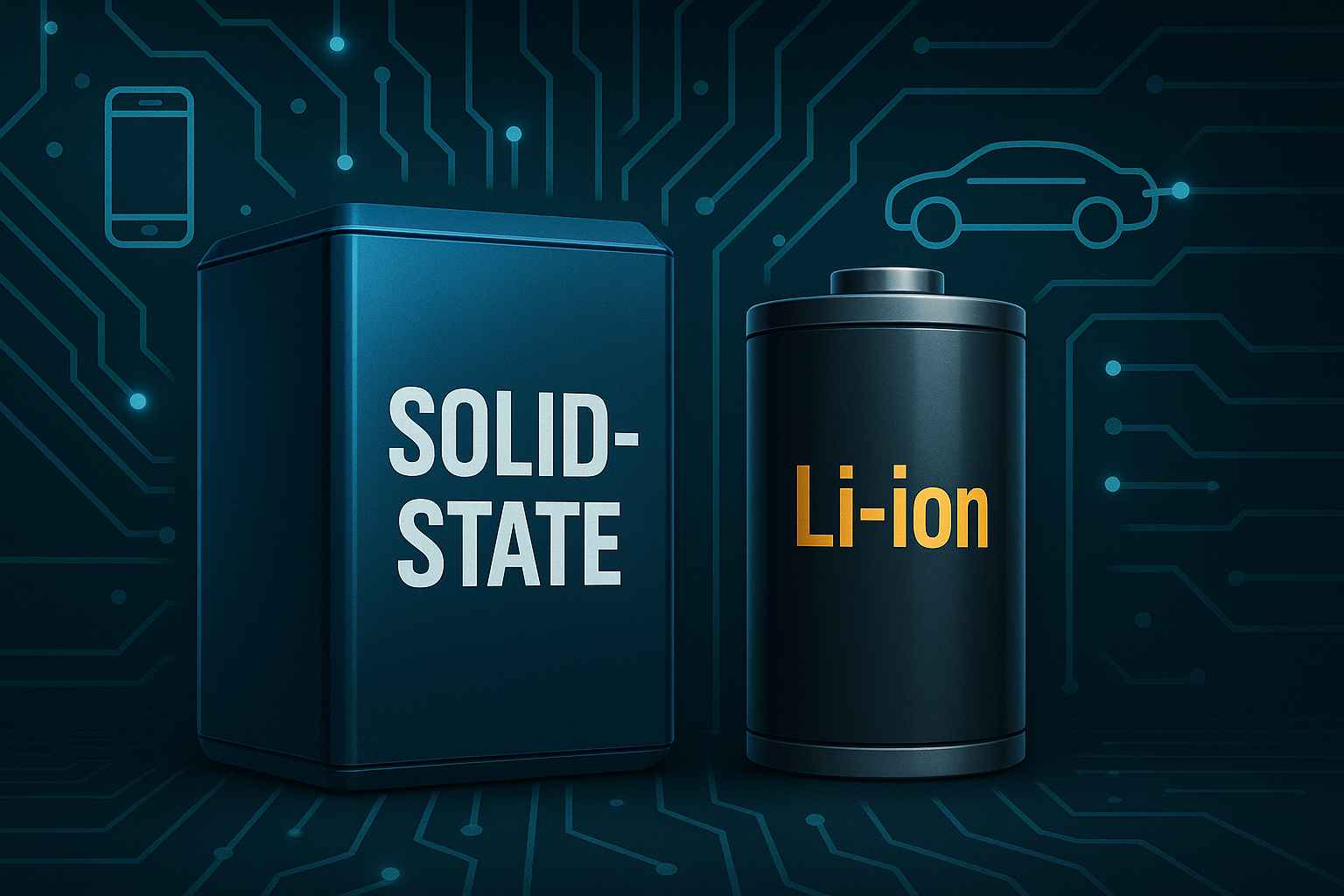🔋 What Are Solid-State Batteries? Explained for Beginners (2025)
Meta Description:
Discover what solid-state batteries are, how they work, and why they are considered the future of energy storage. Easy-to-understand guide for beginners.
📖 Table of Contents
- Introduction
- What Is a Solid-State Battery?
- How Does a Solid-State Battery Work?
- Solid-State vs Lithium-Ion Battery (Comparison Table)
- Advantages of Solid-State Batteries
- Limitations and Challenges
- Applications of Solid-State Batteries
- Future of Solid-State Batteries
- FAQs
- Conclusion
🧭 Introduction
Batteries are everywhere—from your smartphone to your electric car. But the batteries we use today are not perfect. They can overheat, degrade over time, and take hours to charge. This is where solid-state batteries come in—a revolutionary upgrade that could change how we power the world.
🧪 What Is a Solid-State Battery?
A solid-state battery is a type of rechargeable battery that uses a solid electrolyte instead of the liquid or gel electrolytes found in traditional lithium-ion batteries.
In simple terms:
- Traditional batteries = liquid inside
- Solid-state batteries = solid materials inside
This small difference makes a huge impact on performance, safety, and lifespan.
⚙️ How Does a Solid-State Battery Work?
Just like lithium-ion batteries, solid-state batteries have three key parts:
- Anode (negative electrode)
- Cathode (positive electrode)
- Electrolyte (medium that moves ions between anode and cathode)
The electrolyte in solid-state batteries is a solid ceramic or polymer. When the battery charges or discharges, ions move through the solid electrolyte, creating an electrical current.
Because there’s no liquid:
- No risk of leaking or explosion
- Higher energy density
- Smaller and more efficient design
🔄 Solid-State vs Lithium-Ion Battery
| Feature | Solid-State Battery | Lithium-Ion Battery |
|---|---|---|
| Electrolyte Type | Solid (ceramic or polymer) | Liquid or gel |
| Energy Density | Higher | Moderate |
| Safety | Very safe (non-flammable) | Risk of overheating/explosion |
| Charging Speed | Faster (in future models) | Slower |
| Lifespan | Longer | Shorter |
| Current Availability | Limited (mostly in labs) | Widely available |
| Cost | Expensive (as of 2025) | Affordable |
✅ Advantages of Solid-State Batteries
1. Higher Energy Density
You get more power in less space, which means smaller and lighter batteries with longer range.
2. Enhanced Safety
No flammable liquid means no fire risk, even in extreme conditions.
3. Faster Charging
Lab tests show solid-state batteries can potentially charge in minutes, not hours.
4. Longer Lifespan
They degrade much slower, offering thousands of charge cycles.
5. Compact Design
They allow for thinner and more efficient battery shapes—perfect for wearables and electric vehicles.
⚠️ Limitations and Challenges
Despite their potential, solid-state batteries face some hurdles:
- High Manufacturing Costs: The materials and process are still expensive.
- Scaling Issues: Making them at industrial scale is not yet perfected.
- Temperature Sensitivity: Some solid electrolytes work poorly at room temperature.
- Limited Commercial Products: Most are still in R&D or prototype phase.
But companies are actively working to solve these problems.
🚗 Applications of Solid-State Batteries
While still emerging, solid-state batteries are expected to power:
- Electric Vehicles (EVs): Toyota, BMW, and Volkswagen are already testing them.
- Smartphones: Longer battery life in thinner designs.
- Drones and Robots: Lightweight power source = better flight time.
- Wearables and Medical Devices: Safer for close human contact.
🚀 Future of Solid-State Batteries
The future looks bright:
- Toyota aims to launch cars with solid-state batteries by 2027.
- QuantumScape and Solid Power are developing breakthrough technologies.
- Mass production could begin before 2030, revolutionizing EVs, aviation, and consumer electronics.
Once the production costs come down, solid-state batteries may replace lithium-ion entirely.
❓ FAQs
Q1: Are solid-state batteries available in the market now?
A: Only in prototypes or limited-use products. Mass-market release is expected within a few years.
Q2: Can I use a solid-state battery in my phone?
A: Not yet. Major brands are working on it, but it’s not commercially available as of 2025.
Q3: Why are they called “solid-state”?
A: Because they use a solid electrolyte instead of a liquid one—hence the term “solid-state”.
🧾 Conclusion
Solid-state batteries aren’t just an upgrade—they are a game-changer. With better safety, longer life, and faster charging, they could transform industries from electric vehicles to smartphones. While we’re still a few years away from mainstream adoption, getting familiar with this technology now will put you ahead of the curve.
Enjoyed this article? 🔔 Subscribe for future updates on battery tech and emerging innovations, or leave a comment below with your thoughts!
